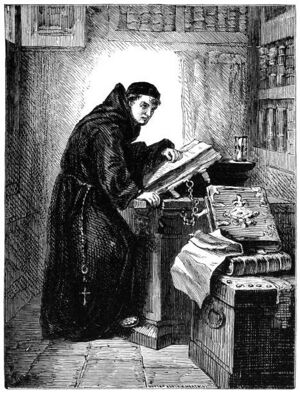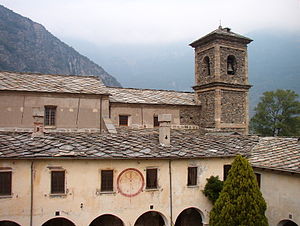Niccolo of Trossera: Difference between revisions
mNo edit summary |
mNo edit summary |
||
| (3 intermediate revisions by the same user not shown) | |||
| Line 1: | Line 1: | ||
{{NonCanon}} | |||
[[File:Niccolo.jpg|thumb|A drawing portraying Niccolo of Trossera by Esquintore Costana (1840–1896). No contemporary depictions of Niccolo have survived.]] | [[File:Niccolo.jpg|thumb|A drawing portraying Niccolo of Trossera by Esquintore Costana (1840–1896). No contemporary depictions of Niccolo have survived.]] | ||
'''Niccolo of Trossera''' (Aciriano: ''Nicolò di Trossera''; c. 698-746) was the most important [[Aciriani people|Acirian]] historian in the 8th century. He is best known for being one of the earliest Catholic monks to take interest in the documentation of the [[Ancient Acirian religion|pre-Christian Acirian religion]] and mythology. He is often seen as the sole reason knowledge of the pre-Christian Acirian religion survived to modern day. He has been described as an avid reader, well versed in various forms of literature from both his time and times before him, and a gifted scholar. Acirian historians often see Niccolo as the most learned man in Aciria in the 10th century, and some even claim the entire Sarpedon. | '''Niccolo of Trossera''' (Aciriano: ''Nicolò di Trossera''; c. 698-746) was the most important [[Aciriani people|Acirian]] historian in the 8th century. He is best known for being one of the earliest Catholic monks to take interest in the documentation of the [[Ancient Acirian religion|pre-Christian Acirian religion]] and mythology. He is often seen as the sole reason knowledge of the pre-Christian Acirian religion survived to modern day. He has been described as an avid reader, well versed in various forms of literature from both his time and times before him, and a gifted scholar. Acirian historians often see Niccolo as the most learned man in Aciria in the 10th century, and some even claim the entire Sarpedon. | ||
| Line 17: | Line 18: | ||
Niccolo is widely considered the best and most influential Acirian historian of the time, famed for his documentation and engaging writing style. Niccolo's works are considered invaluable, and even today he is celebrated as one of Aciria's national heroes for his work in preserving Acirian history in an unprecedented manner. | Niccolo is widely considered the best and most influential Acirian historian of the time, famed for his documentation and engaging writing style. Niccolo's works are considered invaluable, and even today he is celebrated as one of Aciria's national heroes for his work in preserving Acirian history in an unprecedented manner. | ||
[[Category: | [[Category:Burgundie]] | ||
[[Category:IXWB]] | [[Category:IXWB]] | ||
[[Category:People]] | |||
{{Template:Award winning article}} | |||
[[Category:2022 Award winning pages]] | |||
Latest revision as of 11:01, 19 October 2023
This article is non-canonical either because it refers to out-of-character content, the associated nations have left the region, or the information has been retconned. Accordingly, its content should not be considered to be part of the canonical structure of the region's lore.
|

Niccolo of Trossera (Aciriano: Nicolò di Trossera; c. 698-746) was the most important Acirian historian in the 8th century. He is best known for being one of the earliest Catholic monks to take interest in the documentation of the pre-Christian Acirian religion and mythology. He is often seen as the sole reason knowledge of the pre-Christian Acirian religion survived to modern day. He has been described as an avid reader, well versed in various forms of literature from both his time and times before him, and a gifted scholar. Acirian historians often see Niccolo as the most learned man in Aciria in the 10th century, and some even claim the entire Sarpedon.
Ironically, historical records around his birth are lacking, with him being born around 898 in Trossera to an Acirian mother and a Marinai father. He spent all his life in Aciria, and most of his adult life was spent in the Abbey of Santa Beatrice della Montagna in Montanaro country.
Biography
Differing versions of his life exist, but generally it is agreed he was born in or near Trossera. The version often thought as more historical is known as Vita e Morte di Niccolò (Life and Death of Niccolo) written by an unknown monk somewhere in the 9th century. Some attribute the work to one of Niccolo's own students.
Life and Death of Niccolo
According to this tradition, he was born to a low noble family where he had three other siblings. Due to conflict with his siblings, he was sent to Abbey of Pelgiovano in a rural area near Trossera when he was 6 or 7 for an education under Abbot Marinaldi. During his education there he took great interest in philosophy and history, and spent a lot of time near the ancient Acirian temple that was located near the monastery, where he eventually returned as an adult to decipher these. When he was 14, the first abbey in Montanaro country was founded by Marinaldi, and Niccolo likely transferred there with him to aid in the various menial tasks, including possibly assisting in the construction of the monastery. Niccolo's passion for history might've come from Abbot Marinaldi, who was recorded to have been hoarding various historical records into both the Abbey of Pelgiovano, and later in the Abbey of Santa Beatrice della Montagna, giving Niccolo a vast library of historical records to go through.
Niccolo's years between 14 and 25 are vague, but it's known these are the years when he first started translating ancient Acirian texts and visited various ruins of antiquity to study the texts there. When he was 25, he momentarily put the translation and study of ancient Acirian history on hold following the death of Marinaldi, who he held dear and saw as a father figure. He took it upon himself to finish the Storia Grande e Approfondita dei Re di Aciriani (Grand and Thorough History of Acirian Kings) that Marinaldi had started working on a year prior, where Acirian kings were recorded. Many of these figures are thought to be more legend than fact, which Niccolo marked as such. He also translated various biblical texts into Montanaro so it was easier for the new converts in the region to understand.

Following his translation works into Montanaro and the finishing of Grand and Thorough History of Acirian Kings, Niccolo traversed back to the Abbey of Pelgiovano to research the ruins near it and inspect the library at the abbey, eventually spending two years there before returning to Montanaro country. When he did return, he brought two understudies with him who he taught history, holy scripture and philosophy. At 35 he finished his work on Aciria Prima di Cristo (Aciria before Christ), where he documented the beliefs and practices of pre-Christian pagans, including spending extended periods of time with the pagans that still inhabited the Montanaro region at this time. At this time he limited his travels for studies due to back problems, but he sent his understudies to gather information for his next work, Eroi Prima di Cristo (Heroes before Christ), where he detailed the mythology and the heroes of the pagans. He finished this around when he turned 41, the age when he reportedly left the Abbey to live life as a hermit somewhere in the Montanaro region. He kept in regular contact with his favourite understudy, Attavo, who kept him supplied and took finished works back to the abbey for safekeeping. It was on his seventh year as a hermit when Attavo found him dead before a scroll, pen still in hand, and a peaceful expression on his face.
Significance
Niccolo is widely considered the best and most influential Acirian historian of the time, famed for his documentation and engaging writing style. Niccolo's works are considered invaluable, and even today he is celebrated as one of Aciria's national heroes for his work in preserving Acirian history in an unprecedented manner.